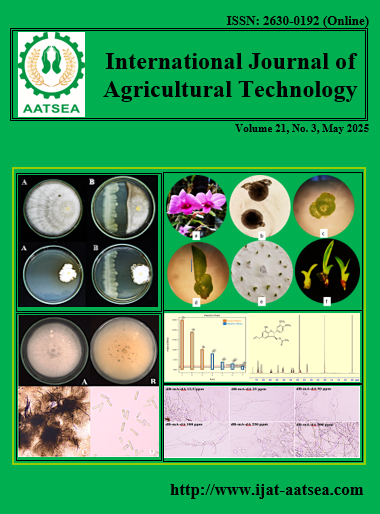Effect of supplementing red pigment from Monascus sp. fermented native black rice (Maepayathong Dum Rice) on production performance and egg quality in laying hens
Main Article Content
Abstract
The results indicated that the addition of red pigments led to a deeper-colored yolk compared to the control group, with the highest intensity observed at a 6% red pigments. Furthermore, the addition of red pigments is promoted the quality of chicken eggs and production performance. It indicated that Maepayathong dum rice could be used as a raw material for producing natural pigments to replace synthetic dyes in egg-laying hen feed.
Article Details

This work is licensed under a Creative Commons Attribution-NonCommercial-NoDerivatives 4.0 International License.
References
AOAC (2000), Official Methods of Analysis of AOAC International, 17th Ed., Maryland, USA.
Babitha, S., Soccol, C. R. and Pandey, A. (2007). Solid state fermentation for the production of Monascus pigments from jackfruit seed. Bioresource Technology, 98:1554-1560.
Chairote, E., Chairote, G., Wongpornchai, S. and Lumyong, S. (2007). Preparation of red yeast rice using various Thai glutinous rice and Monascus purpureus CMU001 isolated from commercial Chinese red yeast rice sample. KMITL Science Journal, 7:28-37.
Chaudhary, V., Katyal, P., Kaur, J., Bhatia, S., Singh, S., Poonia, A. K., Puniya, A. K., Raposo, A., Yoo, S., Han, H., Alturki, H. A. and Kumar, A. (2024). Bioactive activity and safety analysis of Monascus red biopigment. Food Bioscience, 57:103523.
Chaudhary, V., Katyal, P., Panwar, H., Kaur, J., Aluko, R. E., Puniya, A. K. and Poonia, A. K. (2022). Antioxidative, anti‐inflammatory, and anticancer properties of the red biopigment extract from Monascus purpureus (MTCC 369). Journal of Food Biochemistry, 46:e14249.
Cheng, J., Choi, B., Yang, S. H. and Suh, J. (2016). Effect of fermentation on the antioxidant activity of rice bran by Monascus pilosus KCCM 60084. Journal of Applied Biological Chemistry, 59:57-62.
Daud, N. F. S., Said, F. M., Ramu, M. and Yasin, N. M. H. (2020). Evaluation of bio-red pigment extraction from Monascus purpureus FTC5357. In IOP Conference Series: Materials Science and Engineering, 736:022084.
Husakova, M., Plechata, M., Branska, B. and Patakova, P. (2021). Effect of a Monascus sp. red yeast rice extract on germination of bacterial spores. Frontiers in Microbiology, 12:686100.
Huynh, N. T., Camp, J. V., Smagghe, G. and Raes, K. (2014). Improved release and metabolism of flavonoids by steered fermentation processes: A review. International Journal of Molecular Sciences, 15:19369-19388.
Kaur, M., Goel, M., Mishra, R. C., Lahane, V., Yadav, A. K. and Barrow, C. J. (2023). Characterization of the red biochromes produced by the endophytic fungus Monascus purpureus CPEF02 with antimicrobial and antioxidant activities. Fermentation, 9:328.
Lagashetti, A. C., Dufossé, L., Singh, S. K. and Singh, P. N. (2019). Fungal pigments and their prospects in different industries. Microorganisms, 7:604.
Liu, K., Xie, L., Gu, H., Luo, J. and Li, X. (2022). Ultrasonic extraction, structural characterization, and antioxidant activity of oligosaccharides from red yeast rice. Food Science and Nutrition, 10:204-217.
Mehri, D., Perendeci, N. A. and Goksungur, Y. (2021). Utilization of whey for red pigment production by Monascus purpureus in submerged fermentation. Fermentation, 7:75.
Mongkontanawat, N., Wongekalak, L., Nonmuang, W. and Thumrongchote, D. (2018). Yoghurt production from germinated native black rice (Maepayatong Dum Rice). International Journal of Agricultural Technology, 14:543-558.
Naraini, S. and Latif, S. A. (2012). Fermented product by Monascus purpureus in poultry diet: effects on laying performance and egg quality. Pakistan Journal of Nutrition, 11:605-608.
Pengnoi, P., Kumla, J., Khanongnuch, C. and Lumyong, S. (2018). Evaluation of red mold rice for cholesterol reduction in the serum and yolks of Japanese quail eggs and its effect on growth performance. Chiang Mai Journal Science, 45:1667-1679.
Punyatong, M. (2012). Lowering of cholesterol in egg by red yeast rice supplement in laying hens. Naresuan Phayao Journal, 5:108-112.
Sangkitikomon, V., Tentumnou, T. and Rodchanasasod, A. (2008). Comparisions of total antioxidants of red rice, black rice and black sticky rice. Journal of Nutrition, 43:16-21.
Shimada, K., Fujikawa, K., Yahara, K. and Nakamura, T. (1992). Antioxidative properties of xanthans on the autoxidation of soybean oil in cyclodextrin emulsion. Journal of Agricultural and Food Chemistry, 40:945-948.
Smith, H., Doyle, S. and Murphy, R. (2015). Filamentous fungi as a source of natural antioxidants. Food Chemistry, 185:389-397.
Su, Y. C., Wang, J. J., Lin, T. T. and Pan, T. M. (2003). Production of the secondary metabolites -aminobutyric acid and monacolin K by Monascus. Journal of Industrial Microbiology and Biotechnology, 30:16-41.
Sun, H., Wu, Y., Wang, X., Liu, Y., Yao, X. and Tang, J. (2015). Effects of dietary supplementation with red yeast rice on laying performance, egg quality and serum traits of laying hens. Italian Journal of Animal Science, 14:532-537.
Wang, J. J. and Pan, T. M. (2003). Effect of red mold rice supplements on serum and egg yolk cholesterol levels of laying hens. Journal of Agricultural and Food Chemistry, 51:4824-4829.
Wang, J. J., Pan, T. M., Shieh, M. J. and Hsu, C. C. (2006). Effect of red mold rice supplements on serum and meat cholesterol levels of broilers chicken. Applied Microbiology and Biotechnology, 71:812-818.
Wong, H. K., Engku Azahan, E. A. and Tan, S. L. (2005). The effect of red yeast rice supplements on egg production, feed intake and egg cholesteron levels of laying hens. Xlth European Symposium on the Quality of Eggs and Egg Products Doorwerth, The Netherland, 23-26 May 2005.
Yong, S. T., Tan, H. Y., Samat, N. and Wong, H. K. (2021). The effect of high monacolin K red yeast rice supplement on performance, egg quality, egg yolk cholesterol, plasma lipids and enzyme profile of laying hens. Animal Production Science, 61:1672-1679.
Zhang, X., Zhao, Y., Yan, W., Wang, P., Li, J. and Lu, Y. (2024). Light stability and mechanism of Monascus pigment under different lights. LWT, 191:115666.


